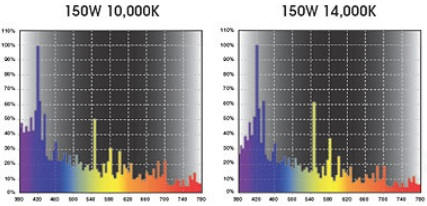THE CORRECT LIGHT SPECTRUM IS IMPORTANT FOR REEF AQUARIUMS
Too often reef aquarists concentrate on providing ideal water chemistry that mimics that found on the reefs and less thought is given toward providing the ideal lighting spectrum for their corals. Water chemistry on the reef is very stable as is the light spectrum that falls on the reefs. The light spectrum will be the same whether you are 20 feet deep onFiji’s reefs or 20 feet deep onHawaii’s reefs. Duplicating the light spectrum is just as important as duplicating the water chemistry if we want our corals to grow and flourish.
To accomplish this, Orphek engineers have worked for years to provide a high Kelvin white LED to provide this spectrum in combination with UV, blue, and wide spectrum red LEDs. The difference between our lights and theirs is that we use less blue and red to achieve the spectrum corals best respond to (400-550nm, 620-700nm). With limited use of blue and red LEDs we can achieve a much higher PAR level than other fixtures provide. Blue and red LEDs emit very low lumens per watt and excessive use of these LEDs lowers the overall PAR of the LED fixture.
Because we do not use orange, yellow, or green LEDs in our systems, the spectrum that nuisance algae flourish at is virtually eliminated. We have conducted numerous experiments to back up this statement. We have proven that excessive use of red, green, and yellow LEDs lead to excessive algae growth as well as the dreaded cyanobacteria.
You can see from viewing the video how much the use of colored LEDs promotes algae growth. Many aquarists believe that the more colored LEDs there are in a fixture, the better it must be. This is very untrue and is detrimental to coral growth and reproduction as well as triggering nuisance algae growth.
Low Kelvin white LEDs can produce the same nuisance algae growth. Many LED manufacturers will use 7,000 to 10,000K off the shelf LEDs in their fixtures and an excessive amount of blue LEDs to compensate for the yellow tinge similar to that emitted by metal halide lamps in the 7,000 to 10,000 Kelvin range. Most reef aquarists would not use lamps in this Kelvin range but freshwater aquarists would benefit their use in growing freshwater aquatic plants. So, why use low Kelvin white LEDs in reef lighting systems? Since no high Kelvin white LEDs are available, Orphek’s goal was to design and produce our own high Kelvin white LEDs in Kelvin temperatures ranging from 16,000-25,000K. What we have successfully accomplished is to provide the correct full spectral range which allowed us to use a minimal amount of blue and our special wide spectrum red LEDs. We do not use off the shelf 640 and 660nm red LEDs and use no algae promoting and PUR reducing orange, green, or yellow LEDs in any of our LED lighting systems. No other LED manufacturing company can claim this. What this does for the reef aquarist is to virtually eliminate the spectrum which nuisance algae flourish at and increase the PAR value in the PUR spectrum.

yellow, orange, and red spectrum. This can lead to nuisance algae growth.
Low Kelvin white LEDs can produce the same results.
Photo courtesy of Ushio Electric

Multi-channel controllers
There are a few LED fixtures available, including our own Atlantik Pendant that allow different channels of light color to be independently controlled. This is fine for short periods in the early morning and late evening viewing but during the photoperiod we recommend that all channels of light be on at an equal intensity. Corals adapt to a specific spectrum and changing this throughout the day can be detrimental to the Zooxanthellae that provide the majority of their food. The effect may look cool to you but we can assure you that it’s not cool for the corals. On the reefs the spectrum never changes, just the intensity.
Our new Atlantik LED Pendant provides four channels of light which can be independently controlled. No green, yellow, or orange LEDs are used, just beneficial LEDs that promote the growth and color of the corals. Colored LEDs may enhance the coral’s color but serves no useful purpose for their growth and reduces the overall PAR/PUR level available to the corals. Yellow and green LEDs emit high lumens per watt and therefore give a higher PAR reading but the PAR level in the PUR spectrum is reduced. To learn more about spectral wavelengths and how they affect corals, please read here.
understanding-spectral-wavelengths
Orphek’s goal has always been to provide high PAR levels in the PUR spectrum and to promote growth of Chlorophyll A and B which further benefits the Zooxanthellae that corals depend on to live and grow.
Orphek LED lighting provides high PAR/PUR, low energy use, no nuisance algae, and no heat. What’s not to love about it?